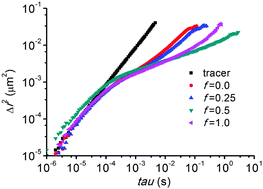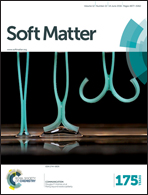Reversible polypeptide hydrogels from asymmetric telechelics with temperature-dependent and Ni2+-dependent connectors†
Abstract
An asymmetric (‘hybrid’) triblock polypeptide TR4H with two different, orthogonally self-assembling end blocks has been constructed by conjugating a long (37 kDa) random coil block (R4) with a triple helix former T = (Pro-Gly-Pro)9 at the N terminus, and a histidine hexamer (‘Histag’, H) at the C terminus. This molecule can form trimers at room temperature by assembly of the T blocks, which can in turn assemble upon addition of Ni2+, by association of Ni complexes involving the H block. This results in reversible hydrogels with dual responsiveness. We have studied mechanical properties of these gels, and compared them to gels formed by the symmetric triblock TR8T which is equivalent to a dimer of TR4H, but can only form triple helix-based networks. We find that there is an optimum mole ratio for Ni2+ with respect to the polypeptide of about 1; gels are weaker at both lower and higher Ni2+ dose. At the optimum dose, the high-frequency storage modulus is in between the value expected for nickel-induced dimerization and trimerization of the H blocks. We also find that the gels relax on time scales of about 50 s, which is two orders of magnitude faster than for TR8T gels, implying that relaxation is dominated by the dynamics of the Ni2+ complex.


 Please wait while we load your content...
Please wait while we load your content...